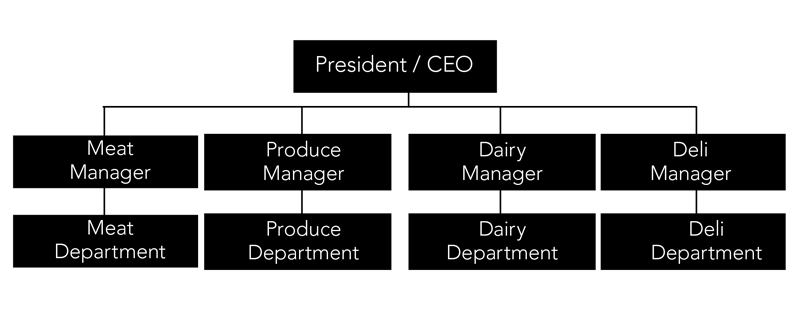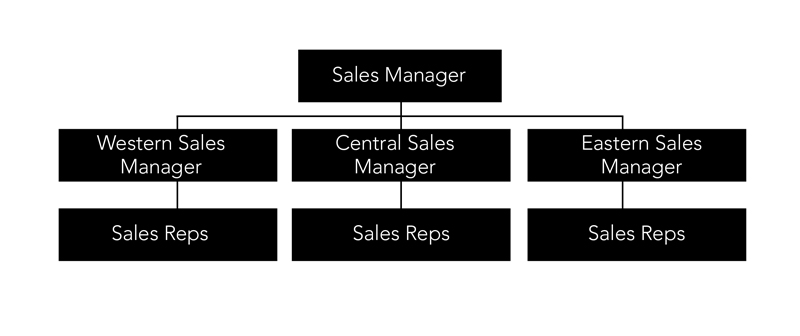Organizational Structure
Your Organizational Structure gives form and shape to your business, much like a skeleton does for your body. It coordinates the work your people do by organizing the working relationships within your business.
You've probably already organized your business this way to some extent. You may have an accounting department or a marketing department, or perhaps you wear several different hats yourself, selling your products, managing your employees, and doing your books at different times of the day. While most businesses operate with some sort of organizational structure, it's typically formed as the solution to a problem, rather than the fulfillment of an organized plan. The story below illustrates this point.
Bob was the owner of a small art supply store. He knew all his customers by name and provided such excellent service that his business grew by leaps and bounds. As his business grew and Bob got busier, he brought in people to take care of the jobs that he didn't want to do or didn't have time to do, such as purchasing, sales and accounting and if Bob found staff members had additional skills that could be useful, such as computer skills, their jobs were adjusted accordingly.
Things went along fine for several years and Bob moved his business into a larger location. Bob was a hard worker and was able to keep up with the growing demands of his business, but as time went on and his business grew, it got more and more difficult. He brought in more people to try to keep up, but the new employees didn't seem to pull their weight. Customers began to complain about poor service and for the first time sales began to slip.
So Bob spent even more time at work. He replaced some of his employees and he tried to personally handle as many clients as he could, but he could only do so much and sales continued to go down. In order to save his business, Bob was finally forced to move back into a smaller location and shrink his business back down to a size he could handle on his own.
When a business grows without forethought, the result is a business that functions in spite of itself. Its growth is likely a result of the owner's heavy involvement in the day-to-day activities of the business. He makes sure that things happen the way they are supposed to and when there is a problem, he solves it. This approach can work while a business is small, but it becomes unworkable as the business grows.

Your Organizational Charts & Relationship Diagrams
The major tools for organizing your business structure are Organizational Charts and Relationship Diagrams.
Organizational Charts represent the reporting relationships in your business. They help determine who should be accountable for what and to whom. Relationship Diagrams represent the working relationships in your business. They help coordinate the way work actually gets done inside and outside your business.
An Organizational Chart represents the structure of accountability and authority in your business, but normal daily activities rarely conform to such a neat and formal structure. Why? While authority and accountability run “vertically” through an Organizational Chart, work is typically accomplished “horizontally.”
Bill from marketing wants to implement a new promotional campaign, but first he needs some input from Susan in finance and Jim in operations. If he went through the formal channels of his company's organizational chart, he'd need to speak with his manager, who would speak with the general manager, who would then speak with the financial and operations managers, who in turn would speak to Susan and Jim respectively (see the diagram below). By the time Bill got his information, an enormous amount of time and energy would have been wasted. So what does Bill do instead? Ideally, he goes directly to Susan and Jim, collects the information he needs right away, and completes his project on schedule.

Formal structure is important for a business, it's what holds the business together and keeps it on track, but it is often the less formal structure of “working relationships” that actually gets things done.
These types of informal relationships exist in every business. They are every bit as important as the formal ones, maybe even more important, yet in most businesses they're taken for granted. It's assumed people will work together when they need to, but no thought is given to how. Then when something goes wrong, people are reprimanded for acting independently. “They should have talked to their manager first.” This only discourages independent behaviour, which, in turn, limits productivity.
To help improve the way work gets done in your business, we'll use a tool called a Relationship Diagram. A Relationship Diagram is simply a flow chart that visually represents the working relationships operating throughout your business. This includes customers, suppliers and relationships in addition to the employee relationships that exist inside your business.
Your Current Organizational Chart
How does your business operate right now? Who does what? Who reports to whom? Who exactly is accountable for getting things done? Without a degree of clarity here, work will not be accomplished in a timely and accurate fashion. Worse yet, important decisions may be deferred indefinitely because authority lines are unclear. The most commonly used tool for developing an organizational structure is an Organizational Chart. It visually represents the flow of authority and accountability through your business. It makes it clear who reports to whom and what their basic functions are.

In the space below, draw an Organizational Chart that represents your business as it currently functions. Use rectangles to represent the main positions in your business and connect them with lines to show reporting relationships (see example above). A single rectangle can also represent a group of positions such as “sales representatives” or “truck drivers.”
Your Future Organizational Chart
In Leadership you created your Strategic Objective, a document describing how your business will look once it has completed its next phase of growth. What will your Organizational Chart need to look like in order to achieve this goal?
The most practical way to organize the flow of accountability and authority varies from business to business. Depending on the size and complexity of your business, you may even find it practical to use different organizational methods for different parts of your business.
Following is a list of various ways to organize any business. As you read through the list keep an open mind. Just because everyone else in your industry does things one way, it doesn't necessarily mean it's the best way. There is no “one right way” to organize a business. What's important is that your organizational structure works for your business, not that it fits the model of any particular design.
1. Function Method
This is the process of organizing your business according to organizational functions or departments (example: sales, personnel, or financial departments).

2. Product Method
Activities are organized according to products or product categories (example: grocery store - meat or produce departments).

3. Process Method
Activities are organized based on the manufacturing process (example: painting or welding departments).

4. Geography Method
Activities are organized according to geography (example: sales rep for a geographical territory, franchising).

5. Type of Customer
Activities are organized according to customer categories (example: clothing manufacturer - retail and wholesale divisions).

6. Combinations
Any combination of the previous processes (example: A regional sales manager's position might be organized around function and geography).
